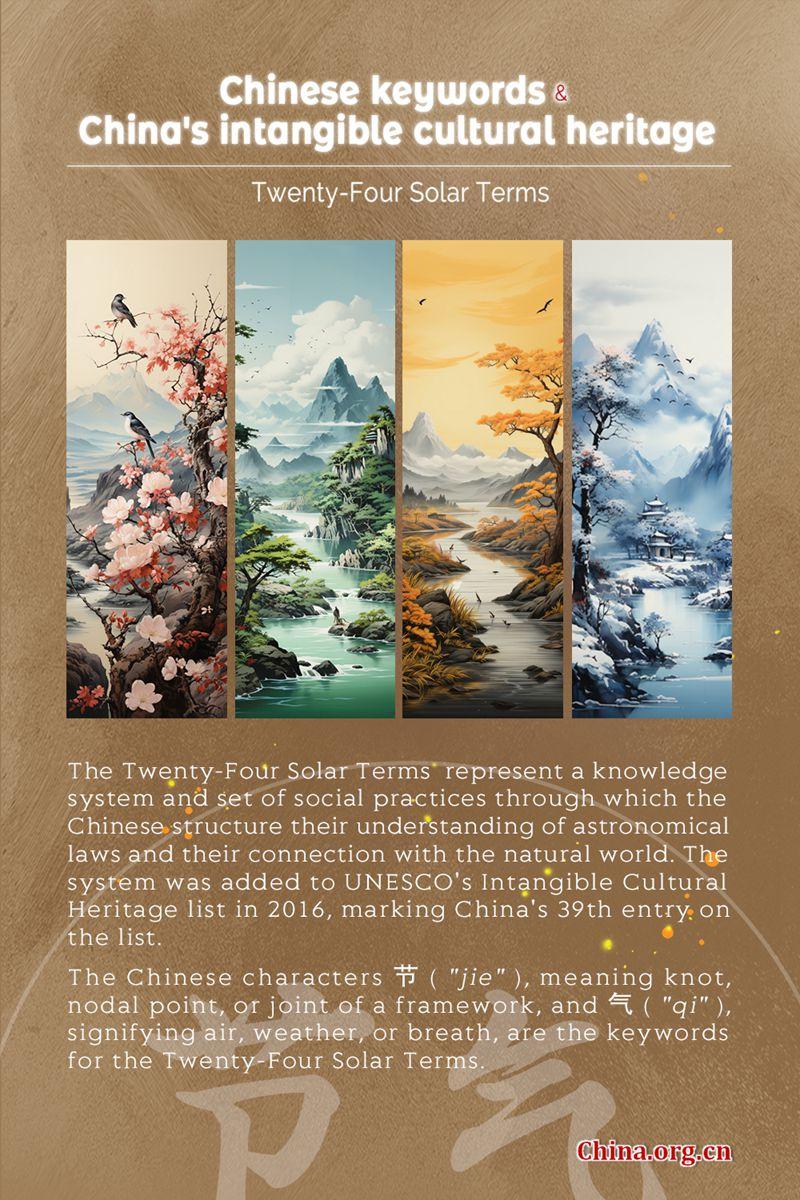Twenty-Four Solar Terms and its Chinese keywords
- By Zhou Jing
 0 Comment(s)
0 Comment(s) Print
Print E-mail China.org.cn, August 21, 2023
E-mail China.org.cn, August 21, 2023
Editor's note: The Twenty-Four Solar Terms represent a knowledge system and set of social practices through which the Chinese structure their understanding of astronomical laws and their connection with the natural world. The system was added to UNESCO's Intangible Cultural Heritage list in 2016, marking China's 39th entry on the list.

The Chinese characters 節 ("jie"), meaning knot, nodal point, or joint of a framework, and 氣 ("qi"), signifying air, weather, or breath, are the keywords for the Twenty-Four Solar Terms.
The ancient Chinese divided the year into four seasons, each consisting of three months, with each month further divided into two solar terms. As such, a full year encompasses 24 solar terms or "jie qi," starting with the Beginning of Spring and culminating with the Greater Cold, thus forming a cyclical pattern.
From an astronomical perspective, the 24 solar terms are defined according to the sun's position on the ecliptic. The Spring Equinox, defined as zero degrees of celestial longitude, marks the beginning, with each subsequent solar term signifying a 15-degree progression. Therefore, when the sun completes a 360-degree rotation, it results in 24 solar terms.
Given the crucial role of agriculture in sustaining life, the ancient Chinese used the system of the Twenty-Four Solar Terms as a comprehensive weather calendar to guide agricultural production. This gave rise to the concept of "seeding in spring, growing in summer, harvesting in autumn, and storing in winter." Its formulation criteria were based on observing changes in astronomical time sequence, air temperature, precipitation and other local natural phenomena.
Today, the system continues to serve as a crucial time directory in agricultural production, aiding tasks such as seeding and harvesting. Each specific solar term prompts people to organize their farming and daily routines accordingly. Moreover, it has evolved into a repository of traditional knowledge and folk wisdom encompassing areas such as astronomy, farming, sericulture, natural history, education, arithmetic and healthcare. It has also permeated cultural expressions such as rituals, poetry, opera, proverbs, chess, calligraphy, painting, architecture, music, dance, literature, film and TV production, children's picture books, and even modern digital applications.
For thousands of years, the Twenty-Four Solar Terms have profoundly influenced the Chinese people's way of thinking and code of conduct, serving as an important carrier of Chinese cultural identity and a vivid testament to the cultural diversity of humanity. This heritage has permeated almost all aspects of Chinese people's lives.
"The element has been transmitted from generation to generation and remains of particular importance to farmers for guiding their practices. Having been integrated into the Gregorian calendar, it is used widely by communities and shared by many ethnic groups in China. Some rituals and festivities in China are closely associated with solar terms. The terms may also be referenced in nursery rhymes, ballads and proverbs. These various functions of the element have enhanced its viability as a form of intangible cultural heritage and sustain its contribution to the community's cultural identity," UNESCO said on its official website.
The Twenty-Four Solar Terms include:
1.Beginning of Spring (Feb. 3-5)
2.Rain Water (Feb. 18-20)
3.Insects Awakening (March 5-7)
4.Spring Equinox (March 20-22)
5.Pure Brightness (April 4-6)
6.Grain Rain (April 19-21)
7.Beginning of Summer (May 5-7)
8.Grain Full (May 20-22)
9.Grain in Ear (June 5-7)
10.Summer Solstice (June 21-22)
11.Slight Heat (July 6-8)
12.Great Heat (July 22-24)
13.Beginning of Autumn (Aug. 7-9)
14.End of Heat (Aug. 22-24)
15.White Dew (Sept. 7-9)
16.Autumnal Equinox (Sept. 22-24)
17.Cold Dew (Oct. 8-9)
18.First Frost (Oct. 23-24)
19.Beginning of Winter (Nov. 7-8)
20.Light Snow (Nov. 22-23)
21.Heavy Snow (Dec. 6-8)
22.Winter Solstice (Dec. 21-23)
23.Slight Cold (Jan. 5-7)
24.Great Cold (Jan. 20-21)
Find out more about China's intangible cultural heritage and their keywords:
China's 43rd UNESCO's ICH element: Traditional tea processing
China's 42nd UNESCO's ICH element: Wangchuan ceremony
China's 41st UNESCO's ICH element: Taijiquan
China's 40th UNESCO's ICH element: Lum medicinal bathing of Sowa Rigpa




